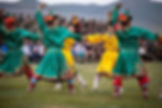Traditional Mongolian Dance: The Living Pulse of the Steppe
- exportmongolia20212
- Aug 17
- 2 min read
Traditional Mongolian dance is a living embodiment of nomadic life, echoing the rhythms of nature, daily tasks, and ancestral rituals. At its heart is the Mongol Biyelgee—a seated folk dance rich in symbolism and heritage.

Traditional Mongolian dance is a vibrant expression of the nomadic spirit, deeply rooted in the rhythms of daily life, nature, and ancestral customs. Among its many forms, the most emblematic is the Mongol Biyelgee, a unique folk dance inscribed on UNESCO’s List of Intangible Cultural Heritage in Need of Urgent Safeguarding.
Mongol Biyelgee: Dance of the Nomads
Originating from the western provinces of Khovd and Uvs, Biyelgee is performed by various ethnic groups including the Dorvod, Torguud, Bayad, and Uuld. It is traditionally danced inside the ger (nomadic dwelling), often while seated or half-sitting, making it distinct from other folk dances.
Key Characteristics:
Upper-body movements dominate—hands, shoulders, chest, and head convey symbolic gestures.
Movements mimic daily tasks: milking, sewing, herding, and spiritual rituals.
Dancers wear richly embroidered costumes, adorned with silver jewelry and ethnic motifs.
Accompanied by traditional instruments like the morin khuur (horsehead fiddle) and yochin.
Cultural Significance
Biyelgee is more than performance—it’s a form of oral history, spiritual expression, and community bonding. It’s performed during weddings, feasts, and seasonal celebrations, reinforcing ethnic identity and family unity.
Preservation & Revival
Once suppressed during the socialist era, Biyelgee has seen a revival through cultural festivals, apprenticeships, and grassroots efforts. However, many of its master practitioners are elderly, and the diversity of regional styles remains at risk.
Other Folk Dance Traditions
Mongolia’s dance heritage includes:
Cup Dance (Dorvod): Women balance cups of milk on their heads while dancing.
Agsal & Tsatsal (Torguud): Heroic and celebratory dances with dramatic flair.
Yokhor & Eeremshih (Buriad): Circular group dances with rapid footwork and chanting.
Each style reflects the landscape, livelihood, and worldview of its people—from the vast steppe to the forested north.
